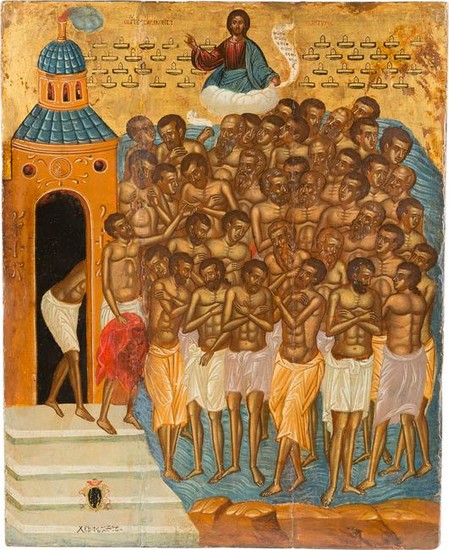GROSSE SIGNIERTE IKONE MIT DEN 40 MAERTYRERN VON
PHILOTHEOS SKOUFOS 1638 Chania/Crete - 1685 Zakythos A LARGE SIGNED ICON SHOWING THE 40 MARTYRS OF SEBASTE Greek, mid 17th century Painted in egg tempera and gold on wood prepared with linen and gesso. The 40 martyrs suffered under the Emperor Licinius in 320 A.D., being made to stand all night in an icy lake near Sebaste, in Armenia, before their execution. Here they are seen on the frozen lake. One figure, is entering the warm bathhouse at left abandoning his suffering companions. Christ is shown above with forty crowns of martyrdom. Their faces painted in the traditional manner with fine shading. Inscribed in Greek lower left beneath a coat-of-arms. On the reverse old inventory label 'MUSÉE D'ART ET D'HISTOIRE GENÈVE Inv. no 000123'. Vertical cracks minimally restored. 54 x 43.8 cm. The well known Cretan icon painter and priest Philotheos Skoufos was born in Chania, Crete as the son of a scholar Frangiscus Skoufas. After the fall of Chania in 1645, Philotheos Skoufos - the abbot of the monastery with 34 monks fought against the Ottomans and the monastery was not destroyed during the war. But he followed the example of many scholars and artists and emigrated. In 1646 he left Crete and went to Corfu, where he collaborated with his colleague, icon painter Emmanuel Tzanes; from 1645 onwards he lived in Venice before he left for Zakynthos in 1665 where he spent the rest of his life until his death in 1685.
FILOTHEOS SCOUFOS 1638 Chania/Kreta - 1685 Zakynthos GROSSE SIGNIERTE IKONE MIT DEN 40 MaeRTYRERN VON SEBASTE Griechenland, Mitte 17. Jh. Verbund dreier Laubholz-Bretter mit zwei Rueckseiten-Sponki. Eitempera auf Kreidegrund, Goldgrund. 54 x 43,8 cm. Am unteren linken Rand signiert sowie Wappenkartusche. Verso Klebeetikett 'MUSÉE D'ART ET D'HISTOIRE GENÈVE Inv. no 000123'. Die 40 Maertyrer sind im Bildzentrum wiedergegeben und nehmen die gesamte Bildmitte ein. ueber ihren Haeuptern schweben auf goldenem Himmelsgrund 40 Kronen, die sie von Christus nach ihrem Martyrium erhalten hatten. Die Darstellung zeigt 40 roemische Legionaere, die sich geweigert hatten, ihrem christlichen Glauben abzuschwoeren. Sie wurden auf Befehl des Kaisers Licinius nackt auf einem zugefrorenen See in der Naehe der Stadt Sebaste ausgesetzt, wo sie erfroren. ueber der Szene erscheint der segnende Christus. Scoufos war ein griechischer Moench und Heiligenmaler des 17. Jahrhunderts. Er war Abt des Klosters Chrysopigis Kantanou in Kandanos. Im Kretischen Krieg von 1645 bis 1669 nahm er mit seinen Moenchen auf der Seite der Venezianer teil. Er bemuehte sich an der Seite von Metropolit Athanasios Bellerianos, die Einwohner beim Widerstand zu unterstuetzen. Spaeter floh er nach Venedig. Von 1665 an ist bezeugt, dass er in der Kirche Panagias Laurentainas in Zakynthos wirkte, die er renovierte. Vertikale Risse entlang der Brettfugen min. rest.
Origin: Griechenland, Mitte 17. Jh.
View it on
Estimate
Time, Location
Auction House
PHILOTHEOS SKOUFOS 1638 Chania/Crete - 1685 Zakythos A LARGE SIGNED ICON SHOWING THE 40 MARTYRS OF SEBASTE Greek, mid 17th century Painted in egg tempera and gold on wood prepared with linen and gesso. The 40 martyrs suffered under the Emperor Licinius in 320 A.D., being made to stand all night in an icy lake near Sebaste, in Armenia, before their execution. Here they are seen on the frozen lake. One figure, is entering the warm bathhouse at left abandoning his suffering companions. Christ is shown above with forty crowns of martyrdom. Their faces painted in the traditional manner with fine shading. Inscribed in Greek lower left beneath a coat-of-arms. On the reverse old inventory label 'MUSÉE D'ART ET D'HISTOIRE GENÈVE Inv. no 000123'. Vertical cracks minimally restored. 54 x 43.8 cm. The well known Cretan icon painter and priest Philotheos Skoufos was born in Chania, Crete as the son of a scholar Frangiscus Skoufas. After the fall of Chania in 1645, Philotheos Skoufos - the abbot of the monastery with 34 monks fought against the Ottomans and the monastery was not destroyed during the war. But he followed the example of many scholars and artists and emigrated. In 1646 he left Crete and went to Corfu, where he collaborated with his colleague, icon painter Emmanuel Tzanes; from 1645 onwards he lived in Venice before he left for Zakynthos in 1665 where he spent the rest of his life until his death in 1685.
FILOTHEOS SCOUFOS 1638 Chania/Kreta - 1685 Zakynthos GROSSE SIGNIERTE IKONE MIT DEN 40 MaeRTYRERN VON SEBASTE Griechenland, Mitte 17. Jh. Verbund dreier Laubholz-Bretter mit zwei Rueckseiten-Sponki. Eitempera auf Kreidegrund, Goldgrund. 54 x 43,8 cm. Am unteren linken Rand signiert sowie Wappenkartusche. Verso Klebeetikett 'MUSÉE D'ART ET D'HISTOIRE GENÈVE Inv. no 000123'. Die 40 Maertyrer sind im Bildzentrum wiedergegeben und nehmen die gesamte Bildmitte ein. ueber ihren Haeuptern schweben auf goldenem Himmelsgrund 40 Kronen, die sie von Christus nach ihrem Martyrium erhalten hatten. Die Darstellung zeigt 40 roemische Legionaere, die sich geweigert hatten, ihrem christlichen Glauben abzuschwoeren. Sie wurden auf Befehl des Kaisers Licinius nackt auf einem zugefrorenen See in der Naehe der Stadt Sebaste ausgesetzt, wo sie erfroren. ueber der Szene erscheint der segnende Christus. Scoufos war ein griechischer Moench und Heiligenmaler des 17. Jahrhunderts. Er war Abt des Klosters Chrysopigis Kantanou in Kandanos. Im Kretischen Krieg von 1645 bis 1669 nahm er mit seinen Moenchen auf der Seite der Venezianer teil. Er bemuehte sich an der Seite von Metropolit Athanasios Bellerianos, die Einwohner beim Widerstand zu unterstuetzen. Spaeter floh er nach Venedig. Von 1665 an ist bezeugt, dass er in der Kirche Panagias Laurentainas in Zakynthos wirkte, die er renovierte. Vertikale Risse entlang der Brettfugen min. rest.
Origin: Griechenland, Mitte 17. Jh.



